How to get more conversions with your Facebook Ads
Posted on 2023-11-01
Introduction
Want to learn how to maximize your Facebook Ad conversions? Stay with us to learn everything about it.
Facebook Ads is one of the most widely used marketing platforms. Whether you provide your prospects with an engaging video or compelling copy, you have just one goal- to make prospects convert. In other words, your main task is to provoke people to perform a specific action like a purchase. Sometimes, optimizing for conversion rates is more difficult to do than to say. It's a great balancing act between creative, budget, and technical possibilities.
Looking for the most valuable tips on how to get more from your Facebook Ads? Then read this article. Here, you will find the most useful hacks for getting a better return on your Facebook ad spend. Here we go!
What are Facebook ads?
Let's start our Facebook ads investigation with the definition of Facebook ads. Facebook ads are more significant than ever. With a huge number of people spending more and more time online on social networks, Facebook ad budgets have remained resilient. However, costs for advertisements are expected to rise in the future.
Since the world of Facebook ads is rising increasingly competitively and algorithms change, every conversion is important. In a contemporary mobile-first society, finding out how to configure the social media landscape is the key to getting more profit.
At its core, Facebook ads are paid messages businesses worldwide use to achieve their target audience. With 2.89 billion monthly active users worldwide, Facebook is a giant of social networks with a permanently increasing audience. During the last decade, Facebook ads have continued to evolve into the huge advertising platform users worldwide know today.
There are several types of Facebook ads that have the same overarching structure:
- Conversions campaign - the basic where you choose your objective and start building the ad.
- Ad Set - this part is the more technical side of the advertisement, including choosing your audience, schedule, budget, and ad placement.
- Ad - at this stage, you create the message your potential customers will see. This block can contain copy, a call-to-action button, top-grade images, videos, and infographics.
4 top Facebook conversion ads benchmarks
Here, you will find a huge number of tools, targeting options, and performance metrics to measure the success of your advertisements. If you are a newbie in this field, it seems overwhelming to start with. Facebook benchmarks give you an average point of reference for certain metrics enabling you to analyze your success, performance, and ad spend.
The best benchmarks to use can differ from one industry to another. We offer you to meet the top Facebook conversion ads benchmarks. Let's consider each of them.
Cost per click
Cost per click (CPC) is how much it costs when a Facebook user clicks on your Facebook conversion ad. The average cost per click across different fields is $1.86.
Cost per view
This Facebook advertising pricing model charges businesses for video views. Pay attention that Meta counts a view as the first three seconds. Therefore, users can not even get to the end of your video. There are other metrics, including seconds viewed, to find out whether the advertisement is successful or not.
Click-through rate
The click-through rate (CTR) is the percentage of viewers who have clicked a link on your Facebook conversion ad. The average click-through on Facebook conversion ads is 0,89 % across different fields. This indicator can be different in different industries. For instance, it's around 0.98% in the real estate industry and around 0.45% in the science field, according to statistics.
Cost per action
Using cost per action (CPA), you still pay for clicks, not for actions. Not every click results in an action.
Say, we have 20 clicks that resulted in 3 actions on our website, and our CPC is 1$. We take the 20$ we spent on clicks and divide it by the number of actions - 3. We get a CPA of 6.66$. This thing can still be tracked and used by Facebook - their algorithms can deliver ads to the users that are likely to take action. But you can not be charged for actions directly.
Other metrics that measure your advertisement's cost-effectiveness and performance contain cost per 1,000 impressions (CPM).
Top tips on how to get more Facebook ad conversions
So, let's consider how you can get more Facebook ad conversions with your Facebook Ads and what strategies you can implement to help you with this.
Create high-converting landing pages
A landing page is a page where your prospects will go while clicking the link on your advertisement. One of the most common mistakes in Facebook ads is that companies want to invest a lot of energy into an amazing Facebook advertisement but ignore the importance of the landing page. The landing page is an integral part of ad success.
Consider your advertisement as a mini version of your landing page. Try to build high-converting landing pages that ensure action. To create a really high-converting landing page, follow these easy-to-do tips:
- Focus on your conversion value proposition;
- Make your landing page easy to understand for your potential customers;
- Apply compelling copy headlines that provoke an action;
- Improve the design of your advertisement to lure potential customers and make readers take action;
- Include social proof.
Understand your target audience
If you strive to boost your conversion rate, it is a great idea to raise your audience and demographics targeting to the next level. No matter your budget, you need to start your conversion rate optimization by investigating your target audience.
Your audience targeting is one of the essential points of achieving success with Facebook conversion Ads. You can create an incredible Facebook conversion ad, but if you combine it with poor targeting, you won't be satisfied with the result.
The combination of excellent audience targeting and compelling and relevant Facebook conversion ads will provide you with high conversion rates. Improving your targeting means applying the Facebook custom audiences ad targeting option on Facebook.
You can apply sources, including customer lists or website traffic, to customize your audience. As a result, you will deliver highly targeted conversion ads to the most relevant users.
Build an engaging lead magnet
A lead magnet is essentially a free item or service that you offer your potential customers for collecting contact data.
For instance, a lead magnet can become a free trial of a subscription service. The main purpose of using a lead magnet is to generate sales opportunities. You can offer free shipping or discounts to attract your potential customers.
The reason why businesses have problems with offering something to customers for free is that most people don't buy anything when visiting a website. By engaging users, you can demonstrate your conversion value while collecting sales leads.
An attractive lead magnet is 100% relevant to your target audience and demands a great understanding of your potential customer's tastes, fears, and motivations.
Develop your creative
The purpose of any Facebook advertisement is to catch potential customers' attention. For this, you need to create something that will stop prospects mid-scroll and makes them pay attention to your advertisement.
Amazing visuals are a very important point in making your ad stand out from thousands of other advertisements. Video content is a powerhouse in marketing since 71 percent of customers think that Facebook ad videos are relevant or highly relevant.
Want to learn how to create amazing video ads for Facebook? Check out our other article here: https://uawc.agency/checklist-to-make-a-video-for-facebook-ads/
To create Facebook ad videos that convert, you should deeply understand the needs of your audience. Remarkably, people want to view short creative videos that are easy to digest. You can notice this effect when viewing Instagram Reels and TikTok. This trend is extended to other social networks, including Facebook.
Create clear CTA's
When it comes to the things that make your advertisement provoke conversions, we need to mention properly built headline, offer, and Call to Action.
Your headline and visuals should grab the user's attention; your copy should lead your prospect through your messaging. However, if you don't create a clear Call to Action, your advertisement will fail.
This sentence needs to stimulate your target audience to take action. So, while building CTA, you should use direct language and create a sense of urgency. Often, writers use "Click Here," but it can be quite vague. It doesn't inform users what benefit they will get while performing the action. So, it's better to use such kinds of CTAs:
- Subscribe;
- Learn More;
- Join Us;
- Sign Up;
- Shop Now.
Our blog post on7 Effective Facebook Ads scripts can further help you with creating engaging ad copies.
Launch Facebook Ads Advantage + Creative Options
To provide optimal conversion campaign performance, you must make your Facebook ads as creative as possible. If your purpose is to reach a relatively niche target audience, you must find out what your ideal customer wants to see in your Facebook conversion ad. For instance, you can iterate on existing conversion ads and use Meta's A/B Testing tool to try new creatives and copy.
The more you extend your targeting and scale your ad conversion campaign, the more difficult it is to design creatives attracting increasingly diverse audiences. A great solution to this problem is split testing, allowing your team to make major decisions between multiple messages or creatives. However, you need to pay attention to copy placement and creative cropping.
To boost conversions and enhance return on ad spend, launch Advantage+ creative options at the end level of Facebook Ads Manager. This tool enables Meta to optimize your conversion ads for each user of Facebook who views them, which will boost conversion campaign results in the future.
You can turn on all available optimizations (at this moment, four) or look through them one by one. For instance, standard improvement can change the aspect ratio of your creative, add templates for certain placements, and showcase particular comments with the ad.
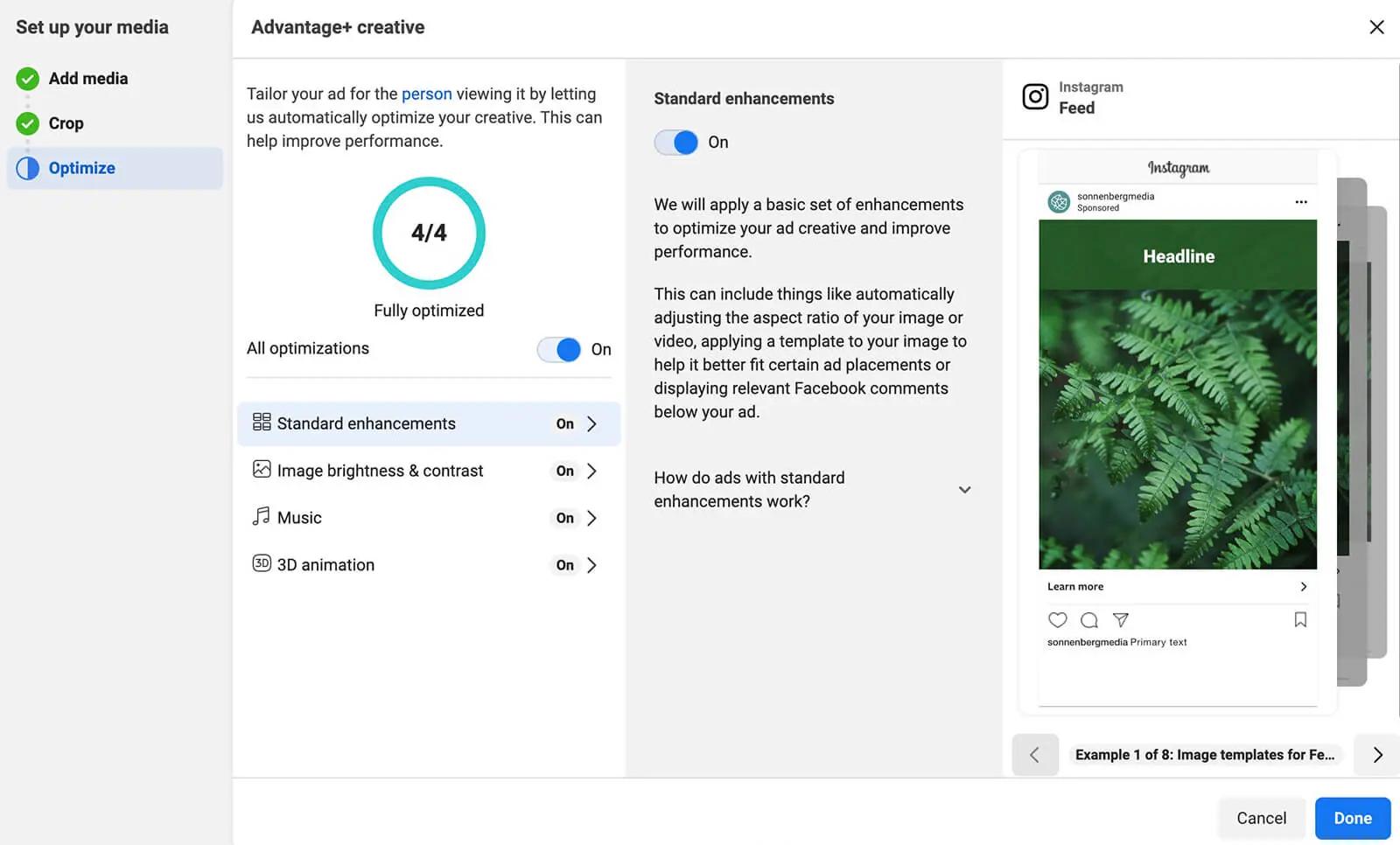
Thanks to the music option, royalty-free music will be added to relevant placements (at the moment, Instagram Reels only) and enables you to create a short list of songs.
Would you like to add all these creative optimizations to an active conversion campaign? You don't need to launch conversion rate optimization on your own, although you can certainly duplicate active ads and launch Advantage+ Creative.
Instead, you can enter your Ads Manager account's automated rules and choose Optimize Ad Creative. You can automatically launch standard upgrades for all eligible conversion ads with a single click.
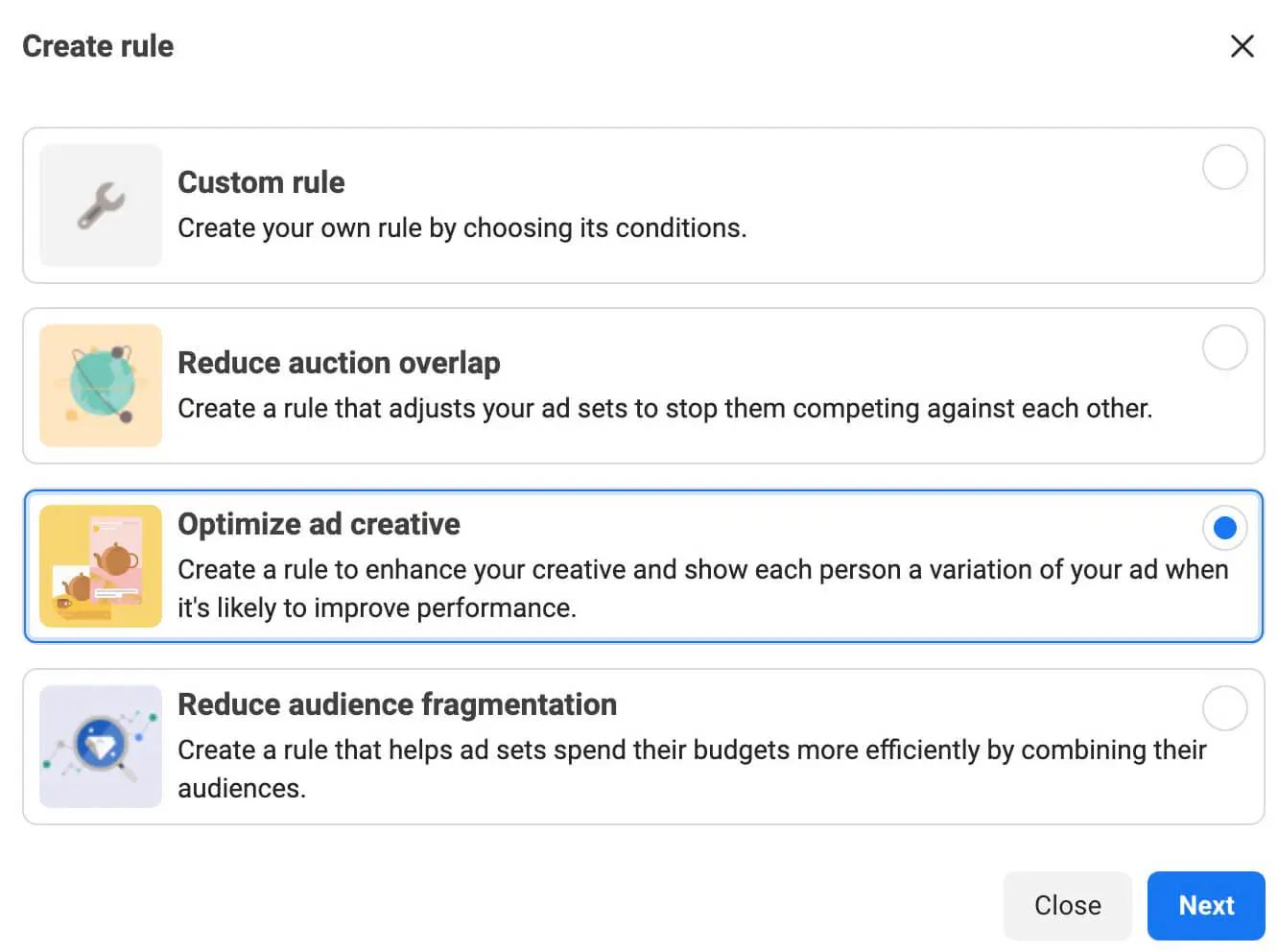
If you have applied split-testing Facebook ads, you can expect Facebook Ads Manager to show breakdowns for each Advantage+ Creative iteration. Pay attention that this tool doesn't ensure detailed breakdowns for improved creatives. Therefore you need to view conversion metrics for each possible iteration.
Launch Tailored Sales Campaign
Recently, Meta has intended to automate all the processes to boost ad results. Meta offers users new options for higher-level campaign streamlining, while Advantage+ Creative mechanisms can boost campaigns at the advertising level. Would you like to start a new Facebook ad campaign using the sales objective? It will be better to apply Ads Manager's new tailored option instead of building a campaign from scratch.
If you choose a tailored setup, Facebook Ads Manager automatically uses the best practices to improve performance. Mostly, it means using a bid strategy with high volumes, launching Advantage+ placements, and optimizing for conversions. This option also allows creating dynamically and helps discover your potential ad destination.
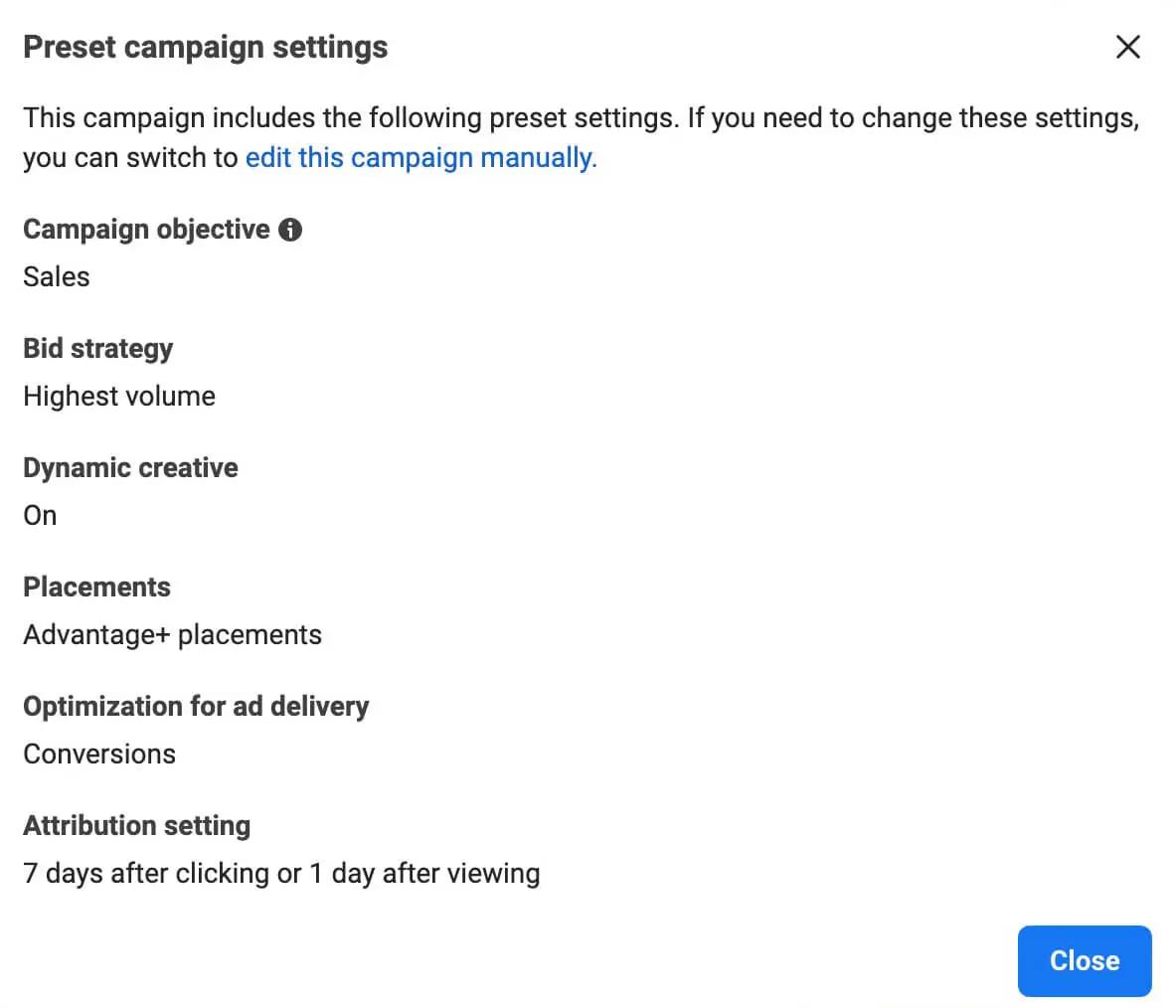
In the tailored campaigns, you can simplify the setup process. For this, you can just validate the campaign and ad settings on a single screen rather than set up each level individually. In addition, they automatically apply the website linked to your Facebook Pixel as a creative source so you can choose and upload visual content faster.
Looking for creative ideas for copy? Currently, you can choose any field to be provided with suggestions. Facebook Ads Manager automatically offers headlines, descriptions, and captions used in previous campaigns and creative and useful copywriting ideas. It offers to view diverse prompts by clicking the See New Options button and selecting one that will be the most profitable for your ad and match your audience.
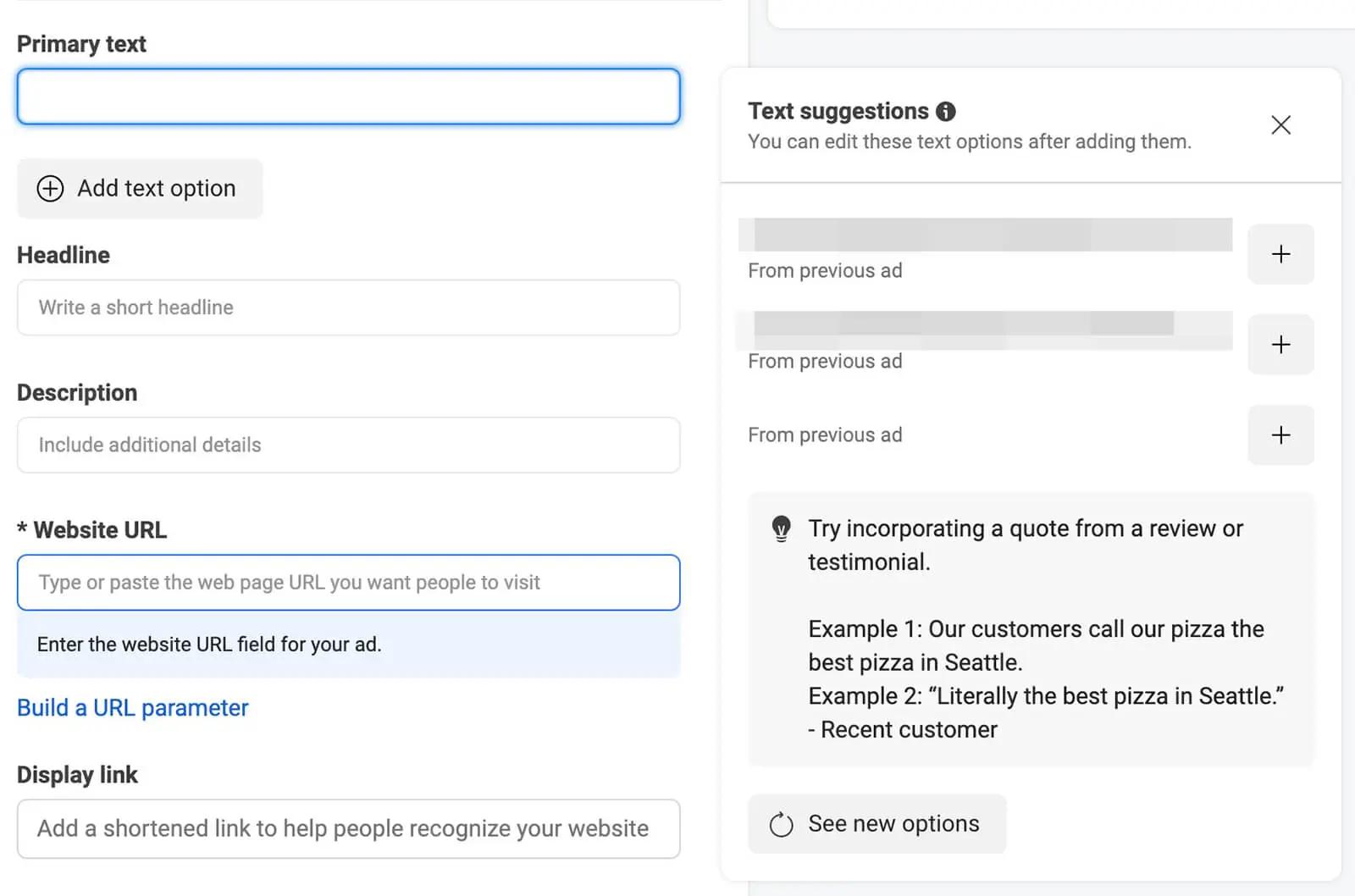
Search for Top-Performing Facebook Ads Segments With Breakdowns
Normally, providing Meta with more options to deliver your advertisements can boost conversions. For instance, the Advantage+ Detailed Targeting launch enables Meta to improve advertisement delivery.
At the same time, these automated optimizations can compromise information received from your campaign results. After all, the more you automate audience targeting, the worse you can find out who is converting.
In addition, Meta started to limit its reporting for external conversions when Apple released its App Tracking Transparency Policy in 2021. Ads Manager data mainly focused on engagement, impressions, and clicks rather than revenue-generating actions for campaigns targeting app or website conversions.
Since 2022, Meta's conversion breakdowns have offered much more helpful insights and enabled advertisers to define top-performing segments. Due to these breakdowns, users can specify genders, ages, and regions for their most profitable customer segments.

By applying this data, you can configure your audience targeting and use demographic filters to cover your best audience. You can also apply this data to optimize your messaging and creatives, turning every point of your conversion ads into a compelling argument for your ideal customer.
In addition, Ads Manager breaks down third-party conversions by ad placement and platform so you can look through where your audience tends to convert. If some placements provide better conversion than others, pay attention to them. Also, you need to know that limiting placements can hinder results.
Instead of choosing specific placements, launch Advantage Placements and then edit the most effective placements on your own. If you get the best conversions from Facebook Stories, take care of your Facebook Stories creatives to match the placement and apply Ads Manager tools, including video templates, to boost your creatives in the future.
Create Value-Based Lookalike Audiences for Facebook Ads
Using data from conversion breakdowns, you can significantly improve audience targeting and deliver advertisements to those segments that provide a higher level of conversions. However, this is not a single path to cover more profitable audiences, especially if you want to enhance your Facebook ad campaigns.
While creating lookalike audiences, pay attention to value-based data sources. They apply information from past conversion events to fill lookalike audiences targeting with similarly high-value customers. To build these lookalike audiences, select from your list of value-based sources, including Commerce Manager product catalogs, Meta Pixels, and third-party apps.
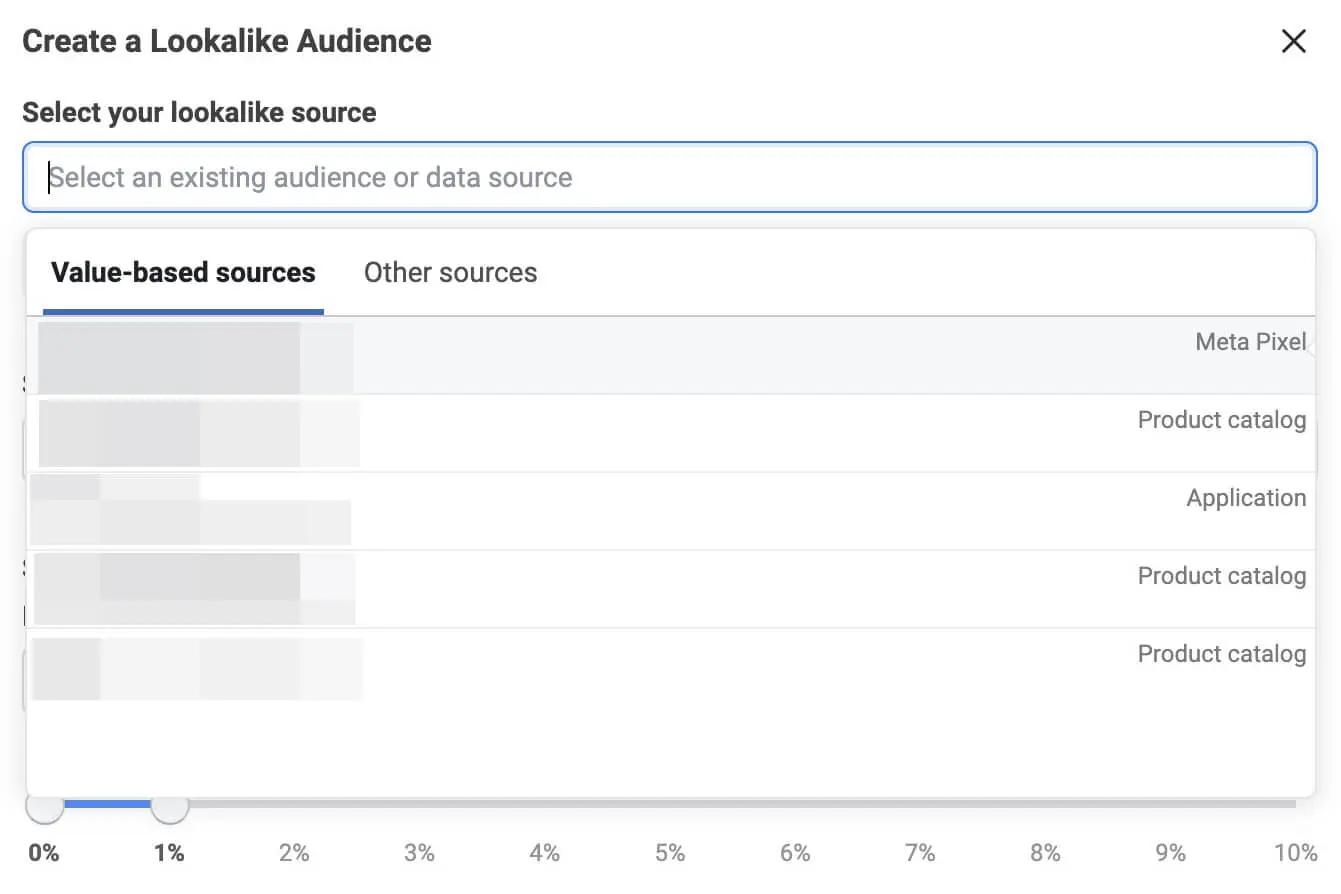
Then choose a value-based conversion event to set up the lookalike audience. Ads Manager uses purchases by default, but you can select other conversion events if you obtain limited purchase data to process them.

Remember that you can only create value-based lookalike audiences built on conversion events configurated in Events Manager. If you haven't looked through your conversion events recently, you must confirm that they are both set up and prioritized.
Launch Multiple Conversion Opportunities for Facebook Ads
Is your conversation rate optimization automated? If you constantly optimize for website conversions or build separate ad sets for each unique conversion opportunity, take some actions to improve your campaign setup.
The multi-objectivity of the Ads Manager campaign allows the creation of multiple conversion possibilities using a single ad set or ad. For instance, this can be used by companies with supported mobile apps and website conversions in sales-focused campaigns at the same time. This means you can configure advertisement sets for both locations and attribute results appropriately.

Do you want to give your potential customers the possibility to call your company? By allowing the Call Extension option at the ad level, it's possible to showcase a phone prompt when someone clicks your ad and visits your website. Using this option, you can enhance your chances of viewing your landing page while allowing customers to get more info or answers to their questions.
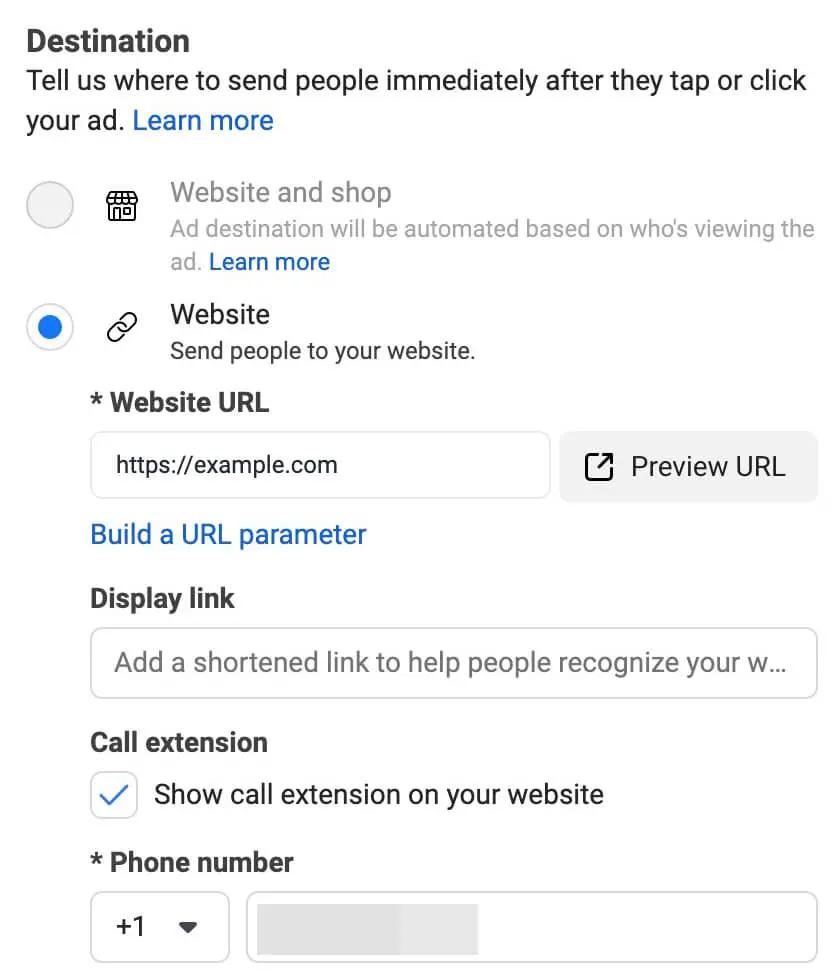
If your brand has a Facebook shop, you can configure the destination to Website and Shop at this level. If you launch this option, Meta will optimize the destination based on each person's typical behaviors.
If you want to generate more leads when launching Facebook ads, the leads objective now enables you to cover both Instant Forms and Messenger at the ad set level. When potential clients interact with an advertisement, Meta will decide where they're most likely to engage and send them to an automated Messenger chat or your native lead form.

Reach In-App Conversions Using Facebook Ads
Enabling multiple conversion options can help you boost results from your Facebook ads. However, suppose your app or website conversions have continued to decrease since Meta has implemented third-party conversion tracking changes according to Apple's App Conversion Tracking Transparency Policy. In that case, you should change your conversion locations.
Rather than setting Facebook Ads to send prospects to your website, engage them through Meta tools. For instance, you can send upper-funnel prospects to Messenger rather than to an external landing page. In addition, it's possible to apply native lead forms for middle-of-funnel prospects to define high-intent leads.
If you reach upper- and middle-of-funnel conversions, you can apply these Meta data sources to build retargeting audiences. After that, you can create audiences built on product catalogs, lead forms, messages, and other native sources that are not subject to the App Tracking Transparency Policy.
Update Facebook Ads Conversion Tracking
Sometimes, you can incorporate in-app conversions into a campaign structure. However, if you need to optimize for conversions on your website or another third-party platform, update your conversion tracking configuration of the account. This will help enhance conversions by resolving outstanding problems, extending data collection, and configuring the stage for better accuracy.
If Meta's standard conversion event fails to indicate the outcomes you need to reach, configure custom conversions in Events Manager. For this, you need to assign a category and establish rules, including referring domain, URL, or event parameters. After that, you need to set up your pixel's web events and custom conversion's priority.

Suppose your eCommerce site automatically generates redirects to subdomains, for instance. In that case, your pixel may get mixed signals. Look through your pixel's diagnostics and follow the steps to manage traffic permissions as necessary.
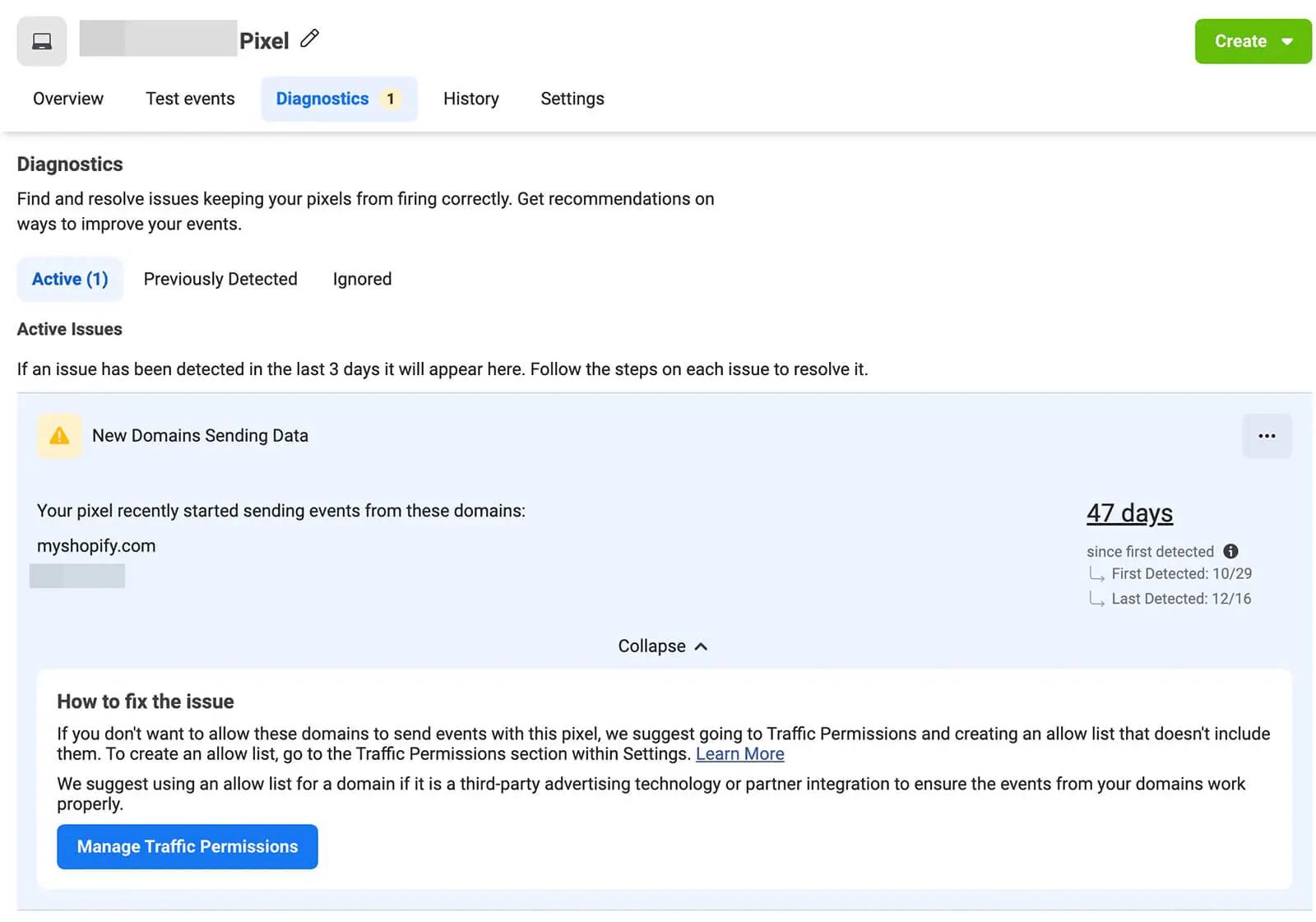
For instance, you should build an allow list or a block list to manage pixel traffic
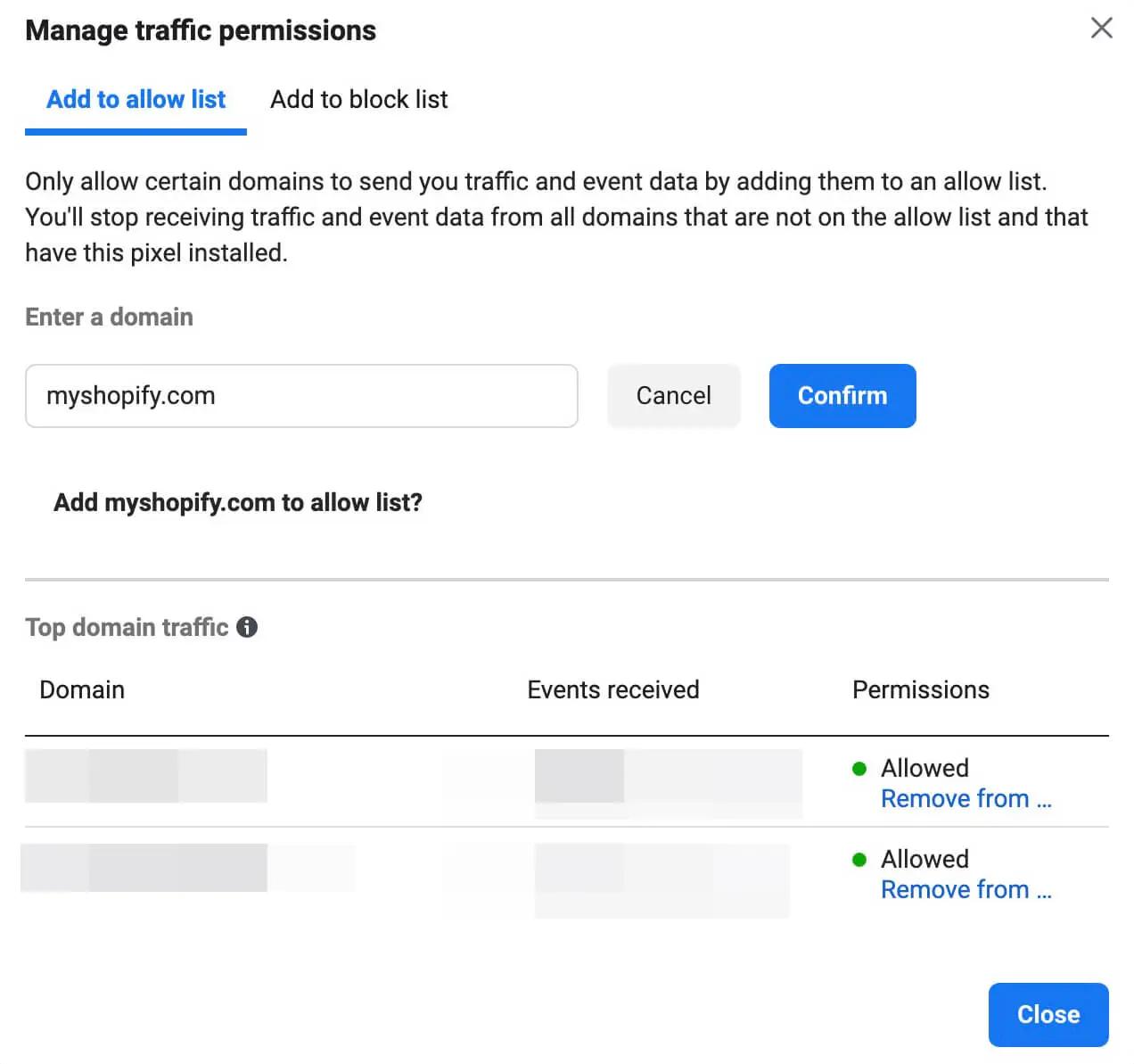
Configuring a Meta pixel using Ads Manager is a great first step for many companies. However, if you want high-level accuracy, you should configure the Conversions API for your account. You can set up Conversions API manually or apply one of Meta's partner integrations to implement its configuration using CMS platforms, including Shopify or WordPress.
View Upper-Funnel Metrics
It doesn't matter which tracking tactics you apply; you should pay attention to data that extends beyond the campaign's primary conversion. You can view campaign performance more accurately while adding upper-funnel metrics to your analytics mix. Therefore, you can define if and where issues are compromising conversions.
For instance, you can boost results from sales-focused Facebook campaigns if you monitor not only conversion metrics. Due to the review of add-to-cart, click-through, and impression metrics, you can find out drop-off points and search for holes in your funnel. High click-through rates followed by low add-to-cart numbers may demonstrate that you have some troubles with the offer.

To view metrics throughout the funnel, you should configure custom columns or reports in Ads Manager. It's better to place the metrics in order of progression through your funnel to define available problems from first sight.
Boost Facebook Ads Automatically With Previously Set Up Rules
When a Facebook ad campaign has hit its stride and starts exceeding key performance indicators (KPIs), you can scale it to create more conversions. However, scaling Facebook ad campaigns manually can be exhausting and takes a lot of time since Meta usually advises enhancing ad set budgets at a rate of about 20% weekly.
By automating the scaling process, you can spend less time completing successful campaigns. To configure it, enter your ad account's automated rules and build a new custom rule. Apply the rule to active ad sets and raise the ad budget by 20% weekly. You can define a maximum daily budget cap to avoid overspending.
After that, you must select the conditions for scaling based on your KPIs. For instance, you may boost campaigns under a certain maximum cost per result. Meta automatically adds a minimum number of lifetime impressions to the conditions list to make sure that the rule only applies to ad sets that have completed the learning phase.

Pay attention to applying automated rule conditions to reach more detailed ad set targeting. For instance, you can use scaling rules to ad sets with conversion-related optimization purposes only to avoid scaling upper-funnel campaigns with a low conversion value per result.
Develop Cross-Channel Touchpoints
While optimizing and scaling Facebook ad campaigns, you shouldn't stop to track conversions metrics and breakdowns throughout the funnel. Search for ineffective touchpoints and find out why they don't cause clicks, engagements, or conversions that you need to have to reach your marketing purpose.
You need to know that Facebook ad campaigns can absolutely help you achieve your marketing targets - even without involvement from other channels. However, cross-channel touchpoints are very useful in guiding potential clients to purchase. For instance, cross-channel touchpoints include:
- Installing a chatbot on your website to engage interested prospects and answer their questions before they click away.
- Encouraging middle-of-funnel potential customers to subscribe to your newsletter to allow you to send drip campaigns supporting prospects who focus on your services or products.
- Launching a Youtube advertising campaign retargeting people who reacted to your Facebook website conversion ads so you can keep your business in your potential customers' minds and provoke them to convert.
In summary
Facebook is one of the large-scale advertising platforms with the potential to reach millions of users. If set up properly, Facebook website conversion ads can become a profitable tool for a business.
However, Facebook ads are extremely competitive, and you can end up investing huge sums in your advertising while getting a low return from your ads. To avoid this, you should include creating high-converting Facebook ads at the core of your social media marketing strategy.
By finding out where your ad may be struggling, you evaluate your current Facebook marketing strategy. You participate in the hard competition where businesses have substantial budgets and digital marketing teams solely dedicated to Facebook ads. However, you can boost your ads to get more conversions using our beneficial conversion-raising strategies and tips.






